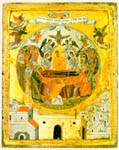|
|
| Portable Icons |
16th c. Pantokrator Monastery Wood, egg tempera, 31 x 24 cm |
|

|
On the main face of this small double-sided icon the Koimesis is depicted in miniature in a circle. The Virgin lies lifeless on a bed, behind which stands Christ, surrounded by angels and holding the Virgin's soul in the form of a swaddled infant in his arms. On either side of the Virgin are Peter and Paul, followed by the rest of the Apostles, prelates, and women. In front of the deathbed, we see the Apocryphal incident involving Jephoniah, the Jew whose hands were cut off by an angel for his impiety. The angel is missing, however, and Jephoniah is followed by two figures of Jews. Below the Koimesis is the walled city of Jerusalem. Above the circle, two angels hold either end of an open scroll, inscribed with a quotation from the Song of Songs: 'Arise, my love, my fair one, and come away, O my dove.' In the upper left corner is St Thomas on a cloud, holding the Virgin's girdle. The iconographical format reflects a known type seen in fifteenth-century works of the Cretan School (Chatzidaki 1993, no. 14). The specific format of the Pantokrator icon, with the main subject in a circle, has a parallel in a late sixteenth-century icon in the Hellenic Institute in Venice (Chatzidakis 1962, pl. 54). The subject on the rear face of the icon is the spiritual 'ladder to heaven' devised by John of Sinai, Hegumen of the Monastery of St Catherine and author of The Ladder of Perfection, a manual written to help monks attain spiritual perfection and the inspiration behind this iconographical theme. According to the Ladder, the prerequisite for spiritual perfection is that a monk should attain the thirty virtues, which in the iconography of the theme take the form of the thirty rungs of a ladder, the ascent of which is beset by temptations in the form of demons tugging at the monks' habits. At the top of the ladder awaits salvation in the person of Christ. He holds an open scroll, on which is inscribed: 'Come unto me, all ye that labour and are heavy laden, and I will give you rest' (Matt. 11:28). This theme, which has its origin in the story of Jacob's Ladder (Gen. 28:12), is a pre-eminently monastic iconographical theme, which was devised around the eleventh century under the influence of the theme of the Last Judgement (Martin 1954, p. 150). It is supplemented in this icon by other, secondary themes depicted on the left against the background of Mount Sinai. On the peak is 'The Koimesis of St Catherine', followed by a representation of the Burning Bush with the Mother of God inside it and below her the summoning of the Prophet Moses (Alibrandis 1991, pp. 31-7). Directly below, an angel in a monk's habit addresses Pachomios: 'In this habit will all flesh be saved, o Pachomios.' The miniature rendering of both themes, the iconographical type of the figures and the technique with which they are rendered, and the realistic depiction of the city of Jerusalem all link the Pantokrator icon with sixteenth-century works of the Cretan School. The same artist painted another double-sided icon of the same size in Pantokrator Monastery, depicting the Recovery and Exaltation of the True Cross and All the Saints.
| |
|
Bibliography: Unpublished
| ||
| E.N.T. | ||
| Index of exhibits of Monastery of Pantokrator 16th century |
||
Reference address : https://www.elpenor.org/athos/en/e218ab75.asp